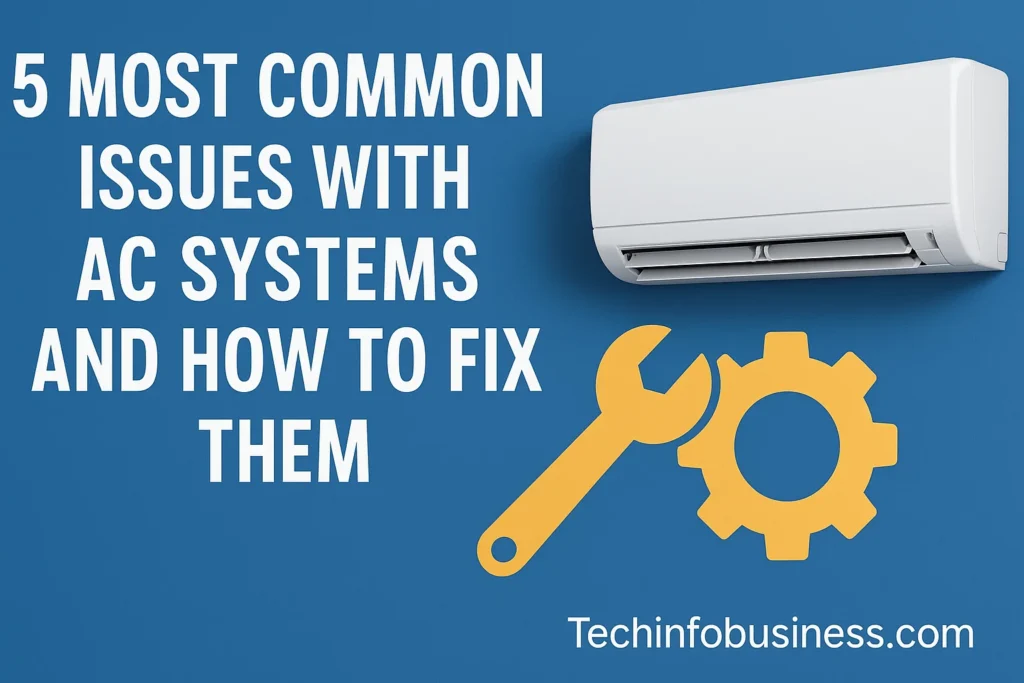Indoor comfort depends on reliable air conditioning, particularly in warmer seasons. While most systems are built to last, there are some problems that can interfere with performance. Early detection of possible issues facilitates prompt repair and maintains system integrity. Here are a few problems that AC systems may have and how air conditioning contractors fix them:
1. Weak Airflow
Weak airflow sometimes occurs when there is an obstruction in the circulation path or when the system’s moving parts are not functioning at their optimum level. A weakened airflow system can take more time to cool rooms, leading to extended operation and added strain on components. Air conditioning contractors inspect the internal components of the system to determine if parts are blocked or performance has degraded. Reduced airflow can be caused by dust buildup, blocked filters, or motor burnout. Regular service intervals will also prevent the accumulation of debris that hinders normal circulation.
2. Inconsistent Cooling
Once an air conditioning system fails to deliver uniform temperatures across different zones, it may indicate that the temperature does not align with thermostat settings. A steady cooling system relies on several parts operating together to distribute cooled air uniformly. When diagnosing uneven temperature distribution, technicians may check the level of refrigerant and confirm that the system controls are working.
A slight variation in thermostat calibration or sensor location sometimes leads to cooling differences throughout the space. Further attention can be placed on assessing air distribution mechanisms, which must operate without blockage or lag to maintain balance. When this is fixed, the temperature fluctuations tend to normalize, and the environment returns to a predictable comfort level.
3. Warm Air Output
When an AC system blows warm air, it could indicate a break in the refrigerant cycle or a technical issue that prevents effective heat transfer. If the refrigerant pressure is low or major mechanical components are not working, the airflow may not be cool, even if the fan is working. If this happens, make sure that the system is in cooling mode and that the thermostat is functioning within normal limits. In case configuration settings are not the reason, technicians will proceed to evaluate the refrigerant system, identifying potential leaks or compression faults. Effective heat exchange requires proper refrigerant levels and fully functional coils.
4. Frequent Cycling
During normal operation, most AC systems are programmed to turn on and off when the set temperature has been reached. Short or frequent cycles is sometimes a sign of a system imbalance that interferes with normal cooling patterns. Irregular cycling could expose internal components to mechanical stress and reduce the overall lifespan of major components. Some causes of this problem are miscommunications of signals between the thermostat and the cooling system or blockages in the system controls.
In the case of frequent cycling, technicians check the responsiveness of the system to temperature variations and signal accuracy. The system can prematurely shut off when the thermostat reads the wrong indoor temperatures because of improper location or exposure to heat. Cleaning or repositioning the thermostat could help restore normal timing intervals, or technicians will re-adjust controls or change internal settings to maintain uniform operation.
5. Unusual Noises
An efficient AC system may generally be quiet, except for the expected hum of air flow or mechanical operation. Strange noises like rattling, grinding, or buzzing are sometimes indicators of internal disruption. These sounds can be due to unbalanced components, misaligned parts, or foreign materials that hinder movement. To deal with noise issues, experts examine all moving parts and look at loose hardware or mechanical friction. Alignment and proper functioning of motors, fan assemblies, and electrical components are tested. Rattling can be caused by loose hardware movement, and grinding at times suggests parts rubbing under tension. Inquire if experts are able to resolve these noise-related concerns through timely tightening, realigning, or replacing worn parts.
Work With Reputable Air Conditioning Contractors
Air conditioning systems may experience performance issues over time. Quick response to these problems, as well as regular servicing, can keep systems running smoothly all year round. These problems, be it mechanical, airflow-related, or due to control misalignment, need technical understanding to fix. In case your system exhibits signs of any of these issues, call a licensed HVAC provider.



